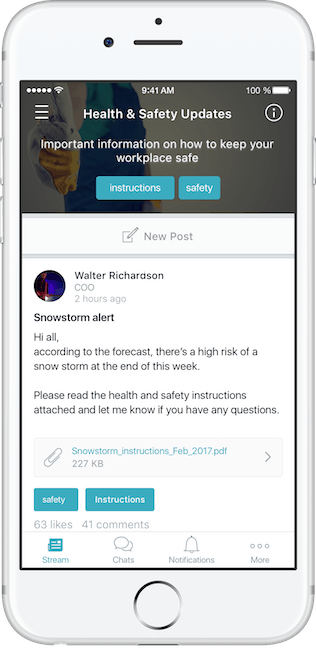When we hear the term, ‘digital workplace’, we tend to focus on the benefits for frontline workers, but going digital is actually a great leadership strategy too.
Communication apps are a workforce solution that will support your day-to-day business decisions by giving you a real-time view of your entire playing field.
Reach every employee instantly to communicate objectives, achieve your goals, and gather workforce feedback so you know what’s going on in every sector of the organization.
With an employee communication app, operations management runs so smoothly, you’ll finally have time to put down the phone and focus on running the rest of the company.
1) Build Your Best Workforce with an Internal Communications App
Executives are responsible for the big picture, but they need a loyal team to help fulfill their vision and business objectives. Leaders build loyalty through solid internal communication, but about half of all workers say they’re in the dark when it comes to their company’s future plans.
With business communication apps, leadership can voice company goals in a clear, direct way so your workforce can support your vision.

Here are just a few benefits of incorporating a group communication app to create your best workforce:
- Transparent internal communication for goal alignment
- Increased productivity through better connections
- Dedication to a shared vision which improves employee retention
Together, these factors create a win-win workforce management solution. As an added benefit, when you open the lines of communication with apps for team communication, frontline staff will give you valuable feedback on areas needing improvement to optimize operations management.
2) Automate Operations Management Logistics with Business Communication Apps
To optimize operations management, delegate tasks within your digital workplace.

Scheduling, payroll, and benefits are important to employees, but they can be time-consuming tasks for management. Integrating them into an app streamlines these HR processes for a more efficient workflow.
By creating automated chatbots in Beekeeper, answers to employee questions can be automated for instant responsiveness. For employees, there’s peace of mind knowing they can easily check their PTO status or obtain paycheck details quickly via their mobile device.
Empower Senior Management with a Business Communication App
A new generation is entering management, yet only 36% of millennials feel prepared for those jobs.
Cultivate a digital workplace that caters to millennials who grew up with technology and are more than ready to embrace it in their careers.
Business leaders can utilize group communication apps in two ways to empower these future leaders:
- Communicate your vision so managers can implement compatible policies that align with the mission.
- Automate training and onboarding while also adding a personal touch
3) Replace Walkie-Talkies with Apps
Communication apps for iPhone and Android are an important part of any effective workforce solution. Adopting one as part of your digital workplace will simplify operations and optimize internal communications for better operations management.
Whether you started out with walkie-talkies decades ago or have recently integrated them into business operations, you likely have multiple complaints about the one-function devices.
You already know mobile communication is essential for frontline employees’ daily activities, but do walkie-talkies really count as a mobile solution? Technology today has so much more to offer than a bulky, single-function device.

Here are seven reasons to replace walkie-talkies with a team communication app.
Cost
For only offering a single mode of communication, walkie-talkies are expensive. A whole-site system can run expenses well into thousands of dollars, and maintenance costs are not cheap, either. Because of the heft of these devices, they often take on a lot of damage, particularly when it comes to models with replaceable batteries.
Apps may present a more significant upfront investment, but their ROI is much higher. As updates emerge and tools expand, teams can continue to use these digital tools in day-to-day operations.
There’s no risk of technology becoming obsolete because of the continuously evolving nature of software development.
Further, business communication apps are particularly cost-effective if you allow employees to BYOD (Bring Your Own Device) because it eliminates purchasing costs of smart devices for all departments.
Even considering the cost of purchasing and maintaining smart devices for an entire company, the difference in initial investment in phones vs. walkie-talkies is significant.
Efficiency
The back-and-forth of walkie-talkie communication can drag on, particularly with out-of-range static, interruptions from other users, and the inability to hear clearly in noisy areas. While these devices have their applications in specific emergency situations, or in cases of internet outages, they are not the most efficient choice for routine communication.
Internal communications apps optimized for mobile let users collaborate remotely via peer-to-peer messaging or newsfeeds, conveying ideas in seconds. The confidentiality of private platform messages far outranks the tell-all mode of walkie-talkies. It also allows your team to elaborate on their ideas without long-winded transmissions.
Technological Advances
Despite the fact that current technology makes touchscreens and voice response functions common offerings, walkie-talkies rely on archaic technology that hasn’t changed much over the past few decades.

For modern corporations, the branding messages and customer-facing approach of the company shouldn’t have such a stark contrast from its technology.
The alternative to continuing to use outdated technology for communication is to adapt to smart device use across all business functions. From hospitality and retail to IT and telecommunications, taking steps to incorporate modern technology not only promotes productivity, but enhances corporate image.
Enhanced Functionality
The physical range is not the only limitation of walkie-talkies, as their single-function approach severely limits a user’s ability to communicate. Without the means to deliver pictures, videos, or subtle messages, teams must rely on alternative methods of internal communication to convey a point.
On the other hand, apps allow for direct peer-to-peer messaging, group messaging, image and other file transfers, and inline translation for diverse groups. These features move beyond even standard cell phone functions, all in a private corporate communication platform.
Crisis Communication
In times of corporate crisis, a walkie-talkie presents only the most rudimentary form of communication and not a clear one at that. If a company experiences a local natural disaster, has a PR crisis, or suspects that competition is about to launch a negative narrative, advanced communication methods are a necessity. In critical situations, mobile communication can prevent a major crisis.

Team communication apps streamline the process of disseminating vital information quickly, whether your crisis is of the natural or PR variety. Group messaging lists, network connections, and even media alerts keep you and your team informed and connected.
See how 1 Hotels used Beekeeper’s team communication app for crisis communications during Hurricane Irma in Florida last summer (starts at 1:25).
Confidentiality
Because walkie-talkies involve voice communication only, there’s no privacy when staff members must communicate in the presence of team members or customers. At the same time, the noise coming from staff walkie-talkies can detract from a brand’s customer experience, whether the organization is a hotel, retail store, or restaurant.
Not only do team communication apps cater to multiple forms of communication like video, pictures, documents, messages etc., but users can expect confidentiality in all matters. Written messages discreetly convey necessary information between team members, without alerting customers to the specifics.
Paper Trail
In industries that value maintenance of a paper trail that proves employee action and conflict resolution, walkie-talkies offer no means of tracking communication. This becomes a challenge when staff receive directions from team members or customers, but cannot record the information they need without scrambling for a piece of paper and a pen.
While corporations can establish confidential communication solutions within internal apps, they can also document employee activity and collaboration for posterity. For teams that work in customer service, this can prove invaluable as information is readily accessible yet discreet should employees require it.
Keep reading to discover how one hotel moved from antiquated internal communication channels like walkie-talkies and bulletin boards to an employee communication app — and the results they had because of it.
How RHW Hotels Uses a Team Communication App to Improve Operations
RHW Management Inc. manages more than 600 employees and nearly 2,000 guest rooms across 19 hotels consisting of five different Marriott brands, Intercontinental Hotels, Hyatt, and Hilton properties.
One of the biggest problems for any hotel property is communication between departments, and for owners of multiple properties, effective communication across their portfolio is next to impossible.
This is where a team communication app helps connect employees. David Montero, Director of Operations at RHW, set out in search of a more robust internal communication and engagement solution.
One that could manage the complexity of communicating with frontline employees across multiple properties within one intuitive interface. He was also looking for ways to increase engagement and enhance corporate culture.
After all, happy employees = happy guests. Do any of these challenges sound familiar? If so, read on for RHW’s journey to improve internal communications and operations, all while giving employees a voice in the organization with their team communication app.
Communication Challenges
RHW faced a number of communication challenges in reaching their large, dispersed labor force.
- Clearly communicating messages from general managers down to the property level
- Information not being shared between shifts
- Outdated internal communication mediums such as bulletin boards and front desk books
How RHW Improved Communications With a Custom Team Communication App
Here’s how Beekeeper’s team communication app helped solve some of RHW’s biggest operational and communication challenges.
- For each property, RHW set up communication streams that covered the daily news and other happenings, including the number of arrivals and departures for the day
- The streams and group chats help set daily expectations because hotel staff could check Beekeeper to see how busy the property was going to be that day
- Employees know what’s happening in the upper levels of the organization through corporate announcements, as well as other property events or news
Properly setting expectations has gone a long way in making his employees feel connected and engaged. Organizational improvements since implementing the team communication app have been remarkable.
It was incredible to see all of the personalities that came alive on Beekeeper that we didn’t realize existed before. Giving our employees a platform allowing them to have a voice has transformed our organization.
– – David Montero
Click here to download the RHW Case Study
A team communication app can transform your operations management in many ways. By improving your internal communication, you can better connect with your staff, increase productivity, and improve your overall efficiency.
It’s basically a win/win/win.




